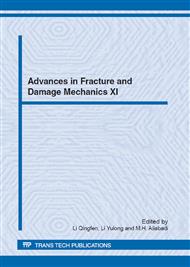[1]
C Atkinson, RE Smelser, J Sanchez. Combined mode fracture via the cracked Brazilian disk test, Int J Fracture (1982), 18: 279-291.
DOI: 10.1007/bf00015688
Google Scholar
[2]
H Awaji and S Sato, Combined mode fracture toughness measurement by the disk test. J Engng Mater Tech(1978), 100: 175-182.
DOI: 10.1115/1.3443468
Google Scholar
[3]
DK Shetty, AR Rosenfield and WH Duckworth, Mixed-mode fracture in biaxial stress state: application of the diametral-compression (Brazilian disk) test. Engng Fract Mech(1987), 26: 825-840.
DOI: 10.1016/0013-7944(87)90032-4
Google Scholar
[4]
C Liu, Y Huang, ML Lovato and MG Stout, Measurement of the fracture toughness of a fiber-reinforced composite using the Brazilian disk geometry. Int J Fract(1997), 87: 241-263.
Google Scholar
[5]
RJ Fowell, Suggested method for determining Mode I fracture toughness using cracked chevron notched Brazilian disc (CCNBD) specimens. Int J Rock Mech Min Sci Geomech Abstr(1995), 32 (1): 57-64.
DOI: 10.1016/0148-9062(94)00015-u
Google Scholar
[6]
J Zhou, Y Wang, YM Xia, Mode-I fracture toughness of PMMA at high loading rates. J. Mater. Sci. ( 2006), 41(24): 8363-8366.
DOI: 10.1007/s10853-006-0980-0
Google Scholar
[7]
MR Ayatollahi and MRM. Aliha, Mixed mode fracture in soda lime glass analyzed by using the generalized MTS criterion, Int. J. Solids Struct(2009), 46: 311-321.
DOI: 10.1016/j.ijsolstr.2008.08.035
Google Scholar
[8]
SM Dong, Y Wang and YM Xia, Stress intensity factors for central cracked circular disk subjected to compression. Engng Fract Mech( 2004), 71(7-8): 1135-1148.
DOI: 10.1016/s0013-7944(03)00120-6
Google Scholar
[9]
H. GUO, N.I. AZIZ, and L.C. SCHMIDT, Rock fracture toughness determination by Brazilian test, Engng. Geology (1993), 33: 177-188.
DOI: 10.1016/0013-7952(93)90056-i
Google Scholar
[10]
QZ WANG, XM JIA, SQ KOU, ZX ZHANG, and PA LINDQVIST, The flattened Brazilian disc specimen used for elastic modulus, tensile strength and fracture toughness of brittle rocks: analytical and numerical results, Int. J. Rock. Mech. and Min. Sci. ( 2004), 41: 245-253.
DOI: 10.1016/s1365-1609(03)00093-5
Google Scholar
[11]
ANSYS9. 0, USER'S MANUAL. Swanson Analysis Systems Inc.
Google Scholar


